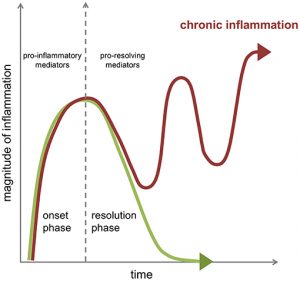Most people are familiar with the myth that everlasting youth can be achieved by traveling to the mystical Fountain of Youth. The legend says that if one drinks from or bathes in the fountain’s water, their youth will be restored. While it appears implausible at the surface, biologists have developed a new tool with the potential to bring the basic idea behind that fantasy to life: slowing down the aging process. Such an implementation begins with an understanding of one’s biological age.
The general concept of biological age considers one’s physiological health; which can vary from a person’s chronological age depending on their physical health status. We are familiar with the common chronic diseases of diabetes and cancer, yet many of us may be unaware of how exactly they arise–via the presence of chronic systemic inflammation (CSI). Recently, studies have confirmed a strong link between CSI and biological aging. As a person ages chronologically, cells in the body become damaged and emit inflammatory molecules into tissues and the bloodstream. These high levels of inflammatory responses within the body lead to CSI. With this in mind, scientists have concluded that inflammation has a large role in physiological aging. When possessing both CSI and a higher biological age, one’s chances of contracting a chronic disease, such as arthritis or heart disease, dramatically amplify. This deeper understanding of the causes of inflammation and how it relates to the mechanism of biological age allows us to measure CSI with new approaches.

Discovered within the last decade, a tool called “DNAm age” has been employed within the field of genetics to measure one’s biological age. The tool utilizes epigenetics, the study of genome modifications that regulate the expression of genes without changing the DNA sequence itself. One kind of epigenetic change is the process of methylation, which is the attachment of a chemical compound called a methyl group to the DNA. The functions of certain genes can be prematurely shut off by methylation related to external stimuli, such as poor lifestyle factors and other environmental influences. To determine one’s biological age, positions along the DNA are examined for the presence of methylation. Years that have passed are marked on the genome based upon the methylation positions. When cells age over time, induced changes move the epigenetic alterations along the genome, indicating an increase in biological age. Taking note of DNA methylation patterns can be difficult and tedious; consequently, large strides have been made to incorporate different methods of measuring biological age.
While DNAm age is sufficient, newer technology draws attention to both the aging and function of the entire immune system when evaluating biological age. Certain inflammatory stimuli, in the form of chemical or metabolic molecules, get released by damaged or aged cells, leading to the development of CSI. This further defines the relationship where CSI greatly increases the chance of contracting a chronic disease. The utilization of this knowledge in a new biological age measurement tool is more significant than previous tools because of the high correlation between inflammation and chronic disease and that inflammation is starting to become increasingly treatable.
Given the large role of chronic inflammation among a multitude of human diseases, researchers have implemented deep-learning methods on blood immune biomarkers to create a metric for biological age-related chronic inflammation. Researchers utilized both a blood test and artificial intelligence to create a straightforward representation of these biomarkers and derive an ‘inflammatory clock’ of biological aging (iAge). The tool directly takes into account the complex relationships of the cytokine network, proteins with a key role in cell signaling, in inflammatory responses. This gives iAge the ability to accurately identify the most influential biomarkers acting on the immune system. Scientists identified a total of fifteen biomarkers, yet the CXCL9 protein was the standout, major contributor to the inflammatory clock. Acting independently of chronological age, CXCL9 has been previously validated as an indicator of the causes and effects of cardiovascular disease, a chronic disease related to CSI. CXCL9 is linked to endothelial cell dysfunction, which are the cells that make up the walls of blood vessels and play a large role in inflammatory reactions. The presence of such an inflammatory biomarker conveys internal damage to the body, including the impairment of vascular function, a weakened immune system, and the potential acceleration of biological aging.
In summary, researchers have identified a dependable measure for systemic, chronic age-related inflammation. This metric displays a strong potential for translational medicine by successfully tracking multiple aging phenotypes, such as cardiovascular aging, frailty, and immune decline, within the general population. Analyzing inflammation from an individual’s blood will be easier to conduct due to the accessibility of lab tests in clinical settings. This tool will further reveal the impact of CSI on patient health and open the door wide for more practical treatment options. By being able to detect one’s immune system status, iAge could be used as a diagnostic tool for identifying individuals at a higher risk for both non-communicable and infectious diseases. Additionally, it can be used as a metric for ‘healthy’ versus ‘unhealthy’ aging: the healthy process of getting older without severe inflammation build-up versus the unhealthy accumulation of inflammation or chronic diseases. With this innovative method, finding ways of maintaining one’s biological age and internal youth is now readily within reach.
The mysterious Fountain of Youth may not be such a foreign notion after all. There currently exists discussion on the possible ways in which to reverse biological aging, where the iAge clock can be used in direct support through its efficiency of evaluating biological age. Currently, over 75% of the world’s population dies due to chronic diseases. Identification of the first major biomarker, CXCL9, opens new doors to finding more biomarkers that could signal age-related diseases. With the remarkable iAge clock, individuals now can have an advantage in maintaining their health compared to previous years. This tool also brings to light the importance of making immunology science more accessible to the public. With numerous infectious diseases and a global pandemic now part of our daily lives, we must begin to acknowledge the health of our immune systems and implement strategies that increase health status surveillance. While it may not constitute total immortality, slowing down the process of aging and creating stronger immune systems carries the great promise of increasing our quality of life.
References:
- https://www.nature.com/articles/s43587-021-00082-y.epdf?sharing_token=qvlvrs5vLcJ5th_oKqV0itRgN0jAjWel9jnR3ZoTv0PG5QZt50iSHFDeOvGhWfEiXaS3BdRG4FUdVumfRFd5JS-80mR5iJZpBuZcgrRClsVphqoZsmAT-FS12Dh_4gnf-vY71g50Xvy-jenEwY8PxtRvhOJ5QyOCfu8ds7qQRsg%3D
- https://www.nature.com/articles/d41586-021-01915-x
- https://www.nature.com/articles/508168a
- https://www.medicalnewstoday.com/articles/aging-clock-uses-ai-to-predict-immune-health-disease-onset#Application-of-the-iAge-clock
- https://onlinelibrary.wiley.com/doi/full/10.1111/acel.13028
- http://iagetest.com/
